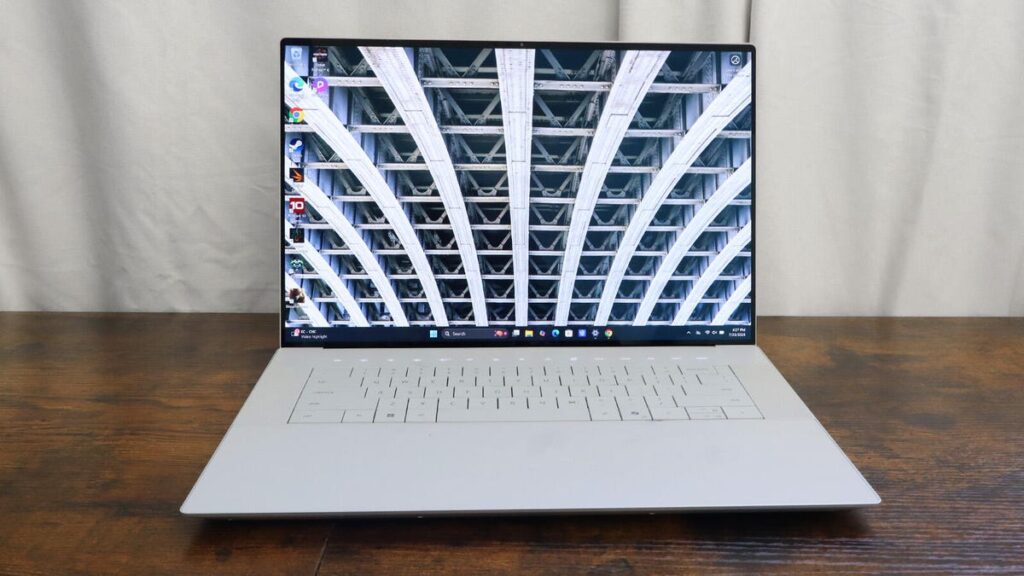ZDNET’s key takeaways
- The Dell Premium 16 starts at $1,800.
- This is a premium laptop capable of handling heavy workloads, especially graphic design, thanks to its top-notch hardware.
- However, it does share some of the same issues as its predecessor, like its tendency to run warm and power-hungry battery.
I’ve been dying to get my hands on the new Dell Premium 16, mainly because it is a follow-up to the Dell XPS 16, a laptop that I reviewed back in early 2024 and one of my favorite devices I’ve tested for ZDNET so far. Although the name may be different, it is a similar computer with key upgrades in all of the right places. However, it shares many of the same issues.
Also: The best laptops for graphic designers: Expert tested
At a glance, you’ll notice that the Dell Premium 16 looks nearly identical to the XPS. The zero-lattice keyboard makes a triumphant return, stretching nearly end to end. Each key has a nice springiness to it, providing a fast, yet comfortable typing experience. Above that is an LED capacitive touch panel where you’ll find the Function and Media keys, a hallmark of the XPS series’ design.
Some familiar designs
Because it’s a glass panel, the Function keys don’t provide any sort of physical feedback, which, to me, is totally fine. Most people don’t interact with the Function keys frequently like they would with the QWERTY keyboard, so the haptic feedback isn’t missed here.
Also: Need a new laptop for the office? Save $400 on the Dell 16 Plus and improve your workflow
Contrary to what you may see, the Dell Premium 16 does have a trackpad at the bottom. It is a glass trackpad that blends seamlessly with the rest of the computer. You can’t see it, but you can feel the haptic feedback. In the image below, I have highlighted where the trackpad is located. You’ll notice that it takes up a significant portion of the wrist rest.
The only discernible difference that I’ve been able to notice between this model and the XPS 16 is the weight. My Dell Premium 16 review unit weighs 4.65 pounds, whereas the older device clocked in at closer to five pounds. It’s a small change, but it makes a difference. Carrying around the Dell Premium 16 across multiple locations is easier.
Jumping out in 4K
The Dell Premium 16 has a wonderfully vibrant 4K OLED touchscreen, delivering ultra-sharp picture clarity. Since the display covers the entire DCI-P3 color gamut, visuals practically leap out at you. On-screen animations are velvety smooth, thanks to the 120Hz refresh rate. It’s not just gamers that appreciate the fast refresh rate; it’s important for video editing as well as it allows the computer to accurately portray video footage as it is intended. For animations, it’s just as crucial.
What really impressed me about its physical form, however, is the InfinityEdge design. Basically, this means the bezels around the glass are thin, providing ample room for the display to show off its impressive specs.
Peak performance
My review unit contained an Intel Core Ultra 7 255H processor, an Nvidia GeForce RTX 5060 graphics card, and 32GB of memory. A configuration that allows for it to excel as a graphic design machine. During my brief time with the Premium 16, I edited photos, created a mobile website layout on Figma, and created 3D models on the rendering app 3D Render.
Dell’s machine performed quite well across all three tasks. Touching up images was smooth as can be, and I was able to generate AI stickers in just a few seconds. With 3D Render, the laptop took everything in stride by rendering all sorts of particle effects, from flames to showers, without skipping a beat. The only downside that I experienced was its heat generation. The bottom of the Dell Premium 16 quickly warms up, the heavier the workload.
Something similar happened with my 50-tab browser test. It easily handled multiple YouTube live streams in 4K, looping GIFs, and many different Amazon listings (among other things), but it got warm fast.
Also: Why I highly recommend the M4 MacBook Air to most people (and now it’s on sale)
If you’re a numbers person, below is a table comparing benchmarking results from the Dell Premium 16 to two other contemporaries: the Alienware 18 Area 51m and the HP EliteBook Ultra G1i. Although the Alienware laptop is primarily a gaming machine, it also doubles as an effective graphic design system.
You’ll notice that Dell’s model sits in the middle of the two. I prefer the Premium 16 above the others because A) its performance is quite solid, and B) it’s cheaper.
|
Geekbench 6 |
PCMark 10 |
Cinebench 2024 |
|
|
Alienware 18 Area-51 |
19,245 |
9,274 |
2,137 |
|
Dell Premium 16 |
14,763 |
6,865 |
726 |
|
HP EliteBook Ultra G1i |
10,993 |
7,328 |
496 |
I should point out that the Dell Premium 16 can function as a solid gaming laptop. However, I wouldn’t recommend using it for that purpose, primarily because, as mentioned earlier, it gets hot. The cooling system on board this machine isn’t as robust as one you’ll find on a gaming laptop, and operating under high temperatures for an extended period of time can lead to long-term damage.
That said, the games I tested all ran fine on Dell’s machine, although I noticed graphical glitches and dropped frame rates while playing “Monster Hunter Wilds” and “Cyberpunk 2077”.
Also: This HP OmniBook finally sold me on the 2-in-1 laptop design (and it’s on sale for $400 off)
Unfortunately, the battery life is not great. It only lasted about five hours on a single charge before tapping out — and that’s with Energy Saver active. There is a saving grace; recharge times are pretty fast. Plugging in the power brick for 30 minutes recharges the battery to about 50%.
ZDNET’s buying advice
Prices for the Dell Premium 16 start at $1,800 for the base model on the company’s official storefront. My review unit currently retails for $2,799 as part of a temporary promotion. If you want a graphic design laptop with extra oomph behind it, I recommend the Alienware 18 Area-51. Its Stealth Mode feature disables all RGB lighting, allowing the gaming laptop to fit right in an office setting. Be mindful of its battery life because it’s not great either.
Personally, I would go with Dell’s laptop. Its performance is rock solid, and it is a more affordable option than the base Alienware 18, which costs $3,200.

